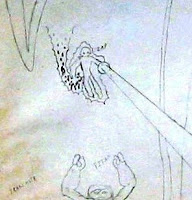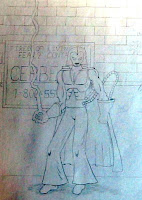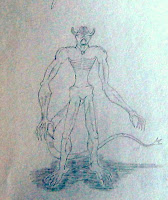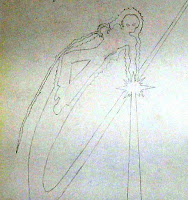 Zzzap is, by far, the most powerful being in the story, and it’s only his own personal limitations which hold him back. He gets queasy and his mental reactions are a lot slower than what he’s physically capable of doing. I wanted a very plain, average name. Dare I say it, a Joe Six-Pack name.
Zzzap is, by far, the most powerful being in the story, and it’s only his own personal limitations which hold him back. He gets queasy and his mental reactions are a lot slower than what he’s physically capable of doing. I wanted a very plain, average name. Dare I say it, a Joe Six-Pack name.Category: Ex-Heroes
November 25, 2010 / 3 Comments
Naming Your Heroes
 Zzzap is, by far, the most powerful being in the story, and it’s only his own personal limitations which hold him back. He gets queasy and his mental reactions are a lot slower than what he’s physically capable of doing. I wanted a very plain, average name. Dare I say it, a Joe Six-Pack name.
Zzzap is, by far, the most powerful being in the story, and it’s only his own personal limitations which hold him back. He gets queasy and his mental reactions are a lot slower than what he’s physically capable of doing. I wanted a very plain, average name. Dare I say it, a Joe Six-Pack name.September 10, 2010
Alphabet Soup
Wow, is it Thursday again already? The three day weekend really threw off my schedule. You get used to things in a certain order and suddenly there’s Thursday, showing up a day early. You expect there to be a few more days in there, y’know…?
Anyway…
I don’t know about the rest of you, but most of my ideas tend to spark with small moments. It’s very rare that an entire story pops into my head fully-formed. I’ve had it happen with a few pieces of flash-fiction and maybe two short stories. For the most part, though, when I start writing something it tends to begin with a random snippet of dialogue or a clever scene of some kind. Then another one. And another. And so on and so forth.
Now, when it comes time to start organizing all of these, I end up with a rough outline of sorts. I say rough because I know there’s a lot of stuff that’s not there. I may have snappy dialogue A and clever reveal B which lead to action scene C, but all the stuff in between… well, there’s usually a lot of discovery in there that doesn’t come out until I start putting words on paper. For example, who would’ve guessed that Danielle’s baseball shirt would be so important in Ex-Patriots? I sure didn’t. I just realized the other day how it tied up a few things into a neat package.
However, there’s also times that I pound my head on the desk for hours trying to figure out what the hell goes between A and B. It can take ages but I usually find something. More often than not, it’s something I’m not thrilled with and it tends to be something that gets cut later.
Which is what I wanted to toss out to you.
If you’ve got A and B, what goes between them?
No, don’t overthink it. Just answer the question. What’s between A and B?
The answer is nothing, which is what a lot of people have trouble with. I had trouble with it for the longest time. Sometimes the reason nothing seems to fit or work between two plot points or story beats is because… well, nothing fits or works between them. There’s a reason no one ever talks about A.5 or A and 3/4.
This is very important in screenwriting, where the goal is to keep everything as lean and tight as possible. When a reader comes across a page of dialogue or action that’s just filler–and it will be apparent to a professional reader that it’s just filler–they’re going to toss that script in the big left hand pile. At the very least, they’re going to be swiveling their chair in that direction and waiting for the next excuse to toss it.
I’ve often mentioned my first real attempt at a novel, The Suffering Map. The first draft of it was bloated, and part of the reason is that I was convinced something had to happen between A and B. And between P and Q. And between V and W. At one point, because I was somehow convinced there needed to be time and space between two events, I had a Mafia boss discover the whereabouts of the guy who slaughtered three of his men and then decide to wait three days before sending people to extract vengeance. Three days that I had to fill up with unnecessary nonsense just because I knew there had to be something between that moment Uncle Louis learns about Rob and the bloody slaughter that followed.
What I eventually realized, though, was that Uncle Louis wasn’t the kind of guy to wait. There was nothing between A and B. Once I realized this and made a few sweeping cuts, the story was stronger and that whole sequence was much more powerful.
The same thing happened once or thrice in Ex-Heroes. I had a few points where characters would go on for a page with random dialogue or actions for no real reason except that I was convinced that there needed to be a break between this and that. Two of my early readers caught these moments and pointed out there was no reason R couldn’t come right after Q. It should come right after Q. That’s how the alphabet works, right?
Now, just to be clear, this doesn’t mean there should never be anything between story points. You may put them next to each other and end up scratching your head at the oddness you just created. Sometimes there really does need to be stuff separating A and B. However, that tells you something right there, doesn’t it? If this is the case, you’re not dealing with A and B, but A and C, or perhaps even A and D. Once you figure that part out, you now know how much needs to go between those two points you have.
So the next time you get stuck trying to figure out what needs to be between A and B, stop for a moment. Try putting your two plot points or story fragments next to each other and see what happens. You may discover you’ve got a solid connection already. At the very least, maybe you’ll get a better idea of what needs to be between them.
Next time, what happens when simple math tricks go wrong.
Until then, make a point to fill in all that blank space on the page. Go write.
April 15, 2010 / 2 Comments
How To Get Away With It
Not really pop culture, but it seemed relevant considering the day. My other option was “This Serves No Purpose!!!” from Galaxy Quest. That’s pop culture and it’s a perfect example of what I wanted to prattle on about.
Alas, taxes are a certainty…
Speaking of taxing something, a while back I mentioned the problem of false drama. It’s when random stuff happens between your characters for no reason. Dot suddenly hates Wakko. Out of nowhere, Yakko is smitten with Phoebe. For motives we can’t understand, Wakko has decided to start arguing with the ninjas. Likewise, I’ve rambled on about motivated action and motivations in general. Stuff don’t “just happen” in a story because there’s a guiding force behind it all–the writer. Even acts of God in a story need to have a purpose.
Things also can’t happen just to fuel the story. That’s the difference between a character’s motivation and the writer’s. Anything in a story that isn’t natural or organic breaks the flow, and one of the worst things a writer can do is give the reader time to sit and think about how ridiculous something in a story is. It taxes their patience and strains suspension of disbelief.
With that being said, sometimes we just need a coincidence or an irrational act. It’s the curse of being a writer. Wakko needs to argue with those ninjas.
Now, I recently got to talk to some of the writers from LOST and an interesting term came up. Every now and then, by nature of their show, the story requires them to put in an odd coincidence or have a character make a very unusual choice. One way they solve this, according to Eddy Kitsis, is by “hanging a lantern on it.”
As the name implies, hanging a lantern on something means drawing attention to it. Not as the writer, but within the story. It’s when something odd or unlikey happens and the characters themselves comment on the oddness or unlikelihood of this.
On LOST, when Sun needs a pregnancy test, she and Kate find one in Sawyer’s stash of scavenged medication and toiletries. And while they’re waiting for the result, they both wonder what kind of person would bring a pregnancy test on an airplane. Really, isn’t that just a bit ridiculous?
In my book, Ex-Heroes, we’re told early on that the Mighty Dragon’s real name is George Bailey. Yes, George Bailey just like in It’s A Wonderful Life. He tells us this himself in a first-person chapter. And then he immediately points out how cruel his parents were and also that he owns the movie and has watched it several times.
So, why does this little trick work?
When the characters themselves immediately acknowledge a choice or action is unusual or ridiculous, it takes the edge off that element for the audience. We can’t forgive the million-to-one coincidence that everyone takes in stride, but we can if the people involve recognize those odds and comment on the unlikeliness of it.
What we wouldn’t forgive is the bizarre coincidence of someone flying with a one-use, specific item like a pregnancy test and everyone ignoring that coincidence. Good characters mirror their audience to some degree, so if the reader thinks this is a bit ridiculous, the characters probably should, too.
Look at Casablanca. It’s got a classic lantern moment. When the film begins, Rick has tried to vanish. He’s gone to another city, in another country, on another continent to escape his previous life, and a few years later the woman who tore out his heart comes walking through the door of his new place. Think about it–the odds of this are astronomical. But we never even consider the odds because Rick himself broods over them in a drunken stupor. “Of all the gin joints in all the world… why did she have to walk into mine?” We accept it because he’s sitting here acknowledging his miserable luck.
Now, does hanging a lantern make a story’s lucky coincidence totally acceptable? Well, not always. What it will do, though, is push back the suspension of disbelief a few notches. By acknowledging this convenient bit of plot or character within the story, the writer’s showing that their characters aren’t stupid, which taxes the reader’s patience. It’s also acknowledging that the reader isn’t stupid, because they just get angry when a writer does that.
So if the coincidence is a small one (say, two guys with the same name also have girlfriends with the same name) and you make a point of commenting on the oddness of it, we as the readers will probably accept it without question. If it’s one of those “you’ve got to be &*%#!ng kidding me!!” type of coincidences… well, you might be able to get it down to a raised eyebrow and a slight eye roll.
It’s also worth keeping in mind, this doesn’t mean you can include dozens and dozens of bizarre coincidences in your screenplay or manuscript and get away with pointing out each one. Like most magic tricks, it’s something you can only do once or thrice before people start to catch on to what you’re really doing. And once they see what you’re doing the illusion’s shattered on a bunch of levels.
Next time around, I’d like to prattle on about that old chestnut, writing what you know, and why fighter pilots don’t always make good writers.
Until then, go write.
February 26, 2010 / 5 Comments
Finish Him!!
Pop culture reference. It’s been a while.
So, first up, I have to do that awful self-promotion thing. Sorry. If you don’t want to see me stoop to shameless commercialism, skip ahead to the paragraph after next.
Over on the side bar, you’ll notice a new addition. The Amazon link for Ex-Heroes, my new novel which came out earlier this week. It’s a story about superheroes battling the zombie apocalypse. If you’re into that kind of thing, you’ll have a lot of fun. If you’re not, it might change your mind and you’ll still have fun. If nothing else, you’ll be able to go back over the rant blog here and understand some of the references I’ve made to this book over the past year and a half or so. You can also hop over to Facebook and join my fan page to get updates on various writing projects, interviews, and the like.
See? Told you it was shameless.
Now, back to our regularly scheduled rant about writing…
A few years back I got to speak with a writing coach named Drusilla Campbell She tossed out an interesting little statistic–one I think has probably expanded in recent years. According to her, out of every 100 people who call themselves writers, only one of them will ever actually finish a project.
One out of a hundred. That was five years ago. I’d be tempted to say it’s probably closer to one in 200 these days. What, with the number of people starting serial novels on the web and such.
By an astonishing coincidence, the number of people who succeed at writing is a somewhat smaller percentage than that. According to Drusilla, it was one out of ten of those folks who completed a manuscript. I think that number’s probably shrunk a bit, too, but not by any more than the other one’s expanded. Maybe one out of twenty or so. I don’t have any hard numbers to back it up, but I have a couple of really solid hunches and chains-of-logic I can share if anyone really wants to see them.
As I mentioned above, a lot of people have trouble finishing stuff. More than 99% of the people who like to say they’re writers never do. There are a couple different reasons for this.
The most common one, of course, is real life. We meet someone who demands more of our time. Something unexpected comes up. Work wants a little more out of us. Sometimes it’s just impossible to give writing the commitment it needs
Some people use it as a sort of fail-safe excuse. Until I finish it I can’t submit it or show it to anyone, and as long as no one sees my writing it can’t be rejected or criticized. So, consciously or not, some people come up with various excuses never to finish anything.
And then there are the folks who just thought it would be easy to write. I mean, anyone can write a book, right? It’s not like it’s a skill you have to learn or practice. We all learned how in grade school, fer cripes sake. These folks get a few dozen pages in and discover writing isn’t easy and it does take a commitment. Some give up quietly while others fall back on some excuse. Worse, a few of these folks actually do rush out an ending just to have it, and often get angry when this slipshod conclusion gets criticized.
I joke a lot about Lizard Men from the Center of the Earth, but here’s an ugly truth about it. I never finished it. Yeah, it was written on yellow paper and twenty-three pages is still impressive for a third-grader, but in the end it was never completed. Even when I revisited it in seventh grade and added illustrations and a shovelful of Arthurian legends. I also didn’t finish the cliché-filled sci-fi epic Piece of Eternity, a God-awful fantasy thing I’ve been trying to block for years (we’ll chalk that one up to excess hormones at puberty), my Boba Fett fan-fiction novel (long before there was such a term as fan fiction),or even the college novel I’ve mentioned a few times, The Trinity. Not one of them finished.
By an astonishing coincidence–the same one I mentioned above, in fact–not one of them sold.
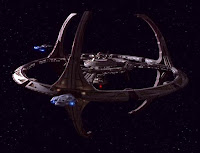 The first long-form project I ever finished was a script for Star Trek: Deep Space Nine called “Point of Origin.” It got me fifteen minutes in a room with Ron Moore to pitch story ideas, plus repeated invites to come up and pitch other stories at the Star Trek offices.
The first long-form project I ever finished was a script for Star Trek: Deep Space Nine called “Point of Origin.” It got me fifteen minutes in a room with Ron Moore to pitch story ideas, plus repeated invites to come up and pitch other stories at the Star Trek offices.
The first novel I finished was The Suffering Map. It got several requests from agents. Big agents, as people like to call them.
A large part of my success as a journalist is the editors know they can toss me an assignment and I will finish it on time. The fact that I’m a competent writer is a big part of it, too, of course, but a lot of it is just the simple fact that they know an article that gets assigned to me will get done by the deadline.
Y’see, Timmy, the point I’m trying to make is that no one’s going to be interested in a partial manuscript or a script fragment. You have to finish something in order to achieve any sort of success. Unless your name is King, Rowling, or Brown, you will not sell an idea to anyone. Don’t assume it’s any different in Hollywood, no matter what some vehement film professor–or film student– tells you. I keep track of script sales for a living and the last time I remember hearing of someone selling a raw idea was five years ago, when David Koepp sold his idea for the film Ghost Town. In other words, to the best of my considerable knowledge on the subject, the last time anyone at a film studio bought just an idea it was a small, indie film concept that was coming from one of the top ten money-making screenwriters in the world.
In other words, for the purposes of all of us here at the ranty blog, it doesn’t happen. You will not succeed as a writer until you finish something. It doesn’t matter that you did nine-tenths of the work and you know how it’s going to end, people want to see all of it–especially that spectacular finish.
We have to write. And we have to finish what we write. If we don’t, we’ve got nothing.
Next week, if no one suggests a new topic, there are going to be some cuts.
Until then go write.



